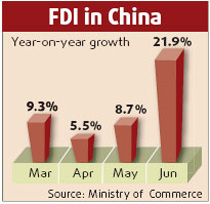Mounting inflationary pressure could slow down China's reform of the pricing mechanism for resource and energy products, economists said.
"The high consumer price index (CPI) has put the central government in a dilemma in terms of reforming its pricing mechanism of resources and utilities," Zhang Zhuoyuan, a researcher with the institute of economics of the Chinese Academy of Social Sciences, said.
"When the CPI stays above 4 percent, there is little room for price hikes of fuel and public utilities."
China's consumer price index, a gauge for inflation, climbed 6.9 percent year-on-year in November, a record high in 11 years, the National Bureau of Statistics (NBS) said on Tuesday.
The Chinese Academy of Social Sciences, a top government think tank, forecasted China's CPI would reach 4.5 percent for 2007 and 4 percent in 2008.
China is poised to further reform the pricing mechanism of resource products next year, according to the Central Economic Work Conference held last week. The move is expected to raise the prices of resource products, bringing them roughly in line with those on the international market.
"The reform will be carried out step by step with careful study, especially for natural gas and petroleum products," Ma Kai, minister of the National Reform and Development Commission, China's top economic planning agency, said.
Prices of petroleum products such as gasoline and diesel have been held low by the government over the past few years, which helped ease inflationary pressure. China raised domestic gasoline and diesel prices by a tenth on November 1, the first increase in 17 months despite the fact international oil prices have almost doubled over the same period.
"Higher utilities prices will definitely give further incentives for local enterprises to increase the efficiency of energy consumption," Zhuang Jian, a senior economist with Asian Development Bank, said.
"But the central government will be careful because increasing utility prices will be passed onto consumers."
Presently, the nation's inflationary pressure has so far been confined mostly to food prices, which accounts for one-third of its CPI basket. Food prices gained 11.3 percent in the first 10 months, accounting for 84 percent of the nation's consumer price gains.
However, the producer price index, an early indicator of price pressures, started to pick up in October, largely due to the rise in oil costs. The rise has caused concern about whether the inflationary pressure had expanded beyond the food sector.
According to the NBS, China's producer prices gained by 4.6 percent year-on-year in November, the largest monthly increase in more than two years.
"We expect continued hikes in energy and resource prices, the utility component of the CPI, will likely continue to be a main contributor to CPI in 2008," Sun Mingchun, a Hong Kong-based economist with Lehman Brothers, said.
(China Daily December 13, 2007)


